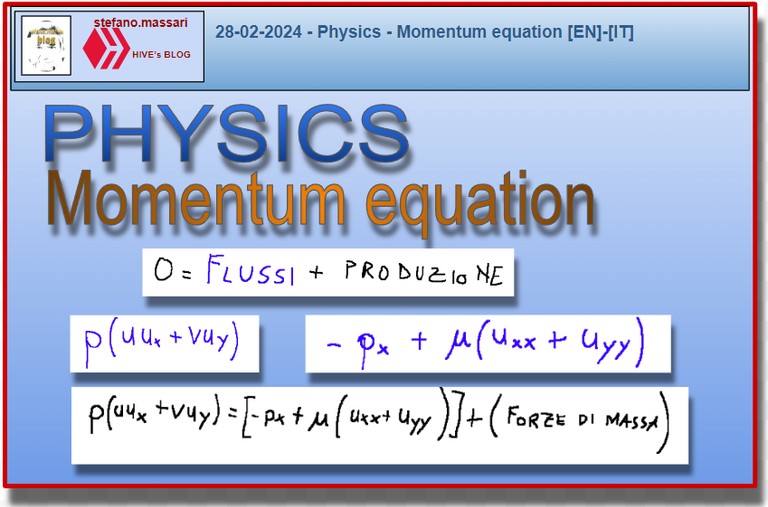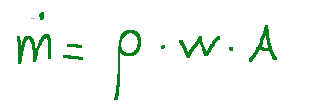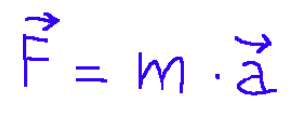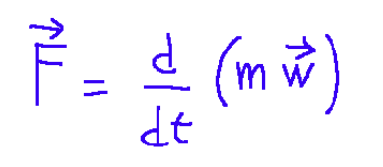28-02-2024 - Physics - Momentum equation [EN]-[IT]

~~~ La versione in italiano inizia subito dopo la versione in inglese ~~~
ENGLISH
28-02-2024 - Physics - Momentum equation [EN]-[IT]
Basic concepts
In thermodynamics it is also important not to forget the basic concepts. When we talk about the mass continuity equation we must always remember two things: mass flow rate and volumetric flow rate.
-Mass flow rate [Kg/sec]

-Volume flow rate [m3/sec]

Momentum Equation
The equation representing the momentum balance (along x) is the following

To represent the momentum equation we can use two methods:
Method 1
To explain this equation we can start from the relationship between applied forces and inertia forces, i.e. the relationship

Where:
F = force expressed in N
m = mass expressed in kg
a = acceleration expressed in m/s2 (meters divided by seconds squared)
This is known as the second law of motion and we note that F and a are vector quantities. This law was introduced by Isaac Newton in 1687.
We can also express this relationship in the following way

Where:
mw = momentum
Therefore mw is an extensive quantity for which the balance can be written
We then elaborate the situation taking into account using the control mass approach.
The transport theorem is then used to move on to the control volume approach.
Finally, it must be taken into account that we are in stationary conditions and that the fluid is incompressible.
The applied forces are mainly of two types: mass forces and contact forces.
In the x direction they are represented by the following term

at this point we can derive the equation that represents the momentum balance.

Method 2
Using the generic budget equation and taking into account the hypotheses involved we will have the following:

Here there are two flows at play:
the convective flow

the diffusive flow

Finally we will therefore have the same solution

Conclusion
The principle of conservation of momentum states that if the resultant of the forces is zero then the initial momentum is equal to the final momentum.
Request
Have you ever had to do calculations where you needed the momentum balance equation? Did you remember the second law of dynamics, F = m * a?

28-02-2024 - Fisica - Equazione della quantità di moto [EN]-[IT]
Concetti base
Nella termodinamica è importante anche non dimenticare i concetti base. Quando parliamo dell'equazione della continuità di massa dobbiamo sempre ricordare due cose: la portata massica e la portata volumetrica.
-Portata massica [Kg/sec]

-Portata volumetrica [m3/sec]

Equazione della quantità di moto
L’equazione che rappresenta il bilancio della quantità di moto (lunga la x) è la seguente

Per rappresentare l'equazione della quantità di moto possiamo usare due metodi:
Metodo 1
Per spiegare questa equazione si può partire dalla relazione tra forze applicate e forze di inerzia, ovvero la relazione

Dove:
F = forza espressa in N
m = massa espressa in kg
a = accelerazione espressa in m/s2 (metri fratto secondo al quadrato)
Questa è conosciuta come la seconda legge della dinamica e notiamo che F ed a sono grandezze vettoriali. Questa legge fu introdotta da Isaac Newton nel 1687.
Questa relazione la possiamo esprimere anche nel modo seguente

Dove:
mw = quantità di moto
Quindi mw è una grandezza estensiva della quale si può scrivere il bilancio
Elaboriamo poi la situazione tenendo conto di usare l’approccio della massa di controllo.
Si utilizza in seguito il teorema del trasporto per passare all’approccio del volume di controllo.
Si deve infine tenere conto che siamo in condizioni stazionarie e che il fluido è incomprimibile.
Le forze applicate sono principalmente di due tipi: forze di massa e forze di contatto.
Nella direzione x sono rappresentate dal seguente termine

a questo punto si può ricavare l’equazione che rappresenta il bilancio della quantità di moto.

Metodo 2
Usando la generica equazione di bilancio e tenendo conto delle ipotesi in gioco avremo ciò che segue:

Qui i flussi in gioco sono due:
il flusso convettivo

il flusso diffusivo

Infine avremo quindi la stessa soluzione

Conclusione
Il principio di conservazione della quantità di moto stabilisce che se la risultante delle forze è nulla allora la quantità di moto iniziale è uguale a quella finale.
Domanda
Avete mai dovuto fare dei calcoli in cui vi è servita l'equazione di bilancio della quantità di moto? La seconda legge della dinamica, F = m * a, ve la ricordavate?
THE END
This calculation looks pretty straightforward and looking easy to understand
Hi @precab thanks a lot to be here. One of the most particular things about this article is the expansion coefficient. First of all we need this to write the budget equation. Below I propose it in its mathematical formula.
This represents the percentage change in density for a change in temperature.
Mistakes that can be made:
Please note that it does not represent a percentage variation in temperature and speed, but a percentage variation in density.
Attention, the percentage variation in density is not due to a variation in speed, but due to a variation in temperature
It's always interesting to learn about thermodynamics and this lesson about momentum is interesting. I have read a little in the past about momentum in physics so I don't know so much about it. But still thanks for the lesson and have a great day.
Thanks @aloysiusmbaba for stopping by. There are two interesting things to understand in this article.
1-The momentum equation is similar to that of forced convection, but in this case mass forces will have to be considered.
2-The expansion coefficient represents the percentage change in density for a change in temperature (it has a dimension equal to the inverse of a temperature)
Below is the mathematical expression of the expansion coefficient.
Can we input number in this and try to solve it?
It may be hard, lol
Dear @rafzat Trying to make a case with numbers is quite difficult, but I would like to do it, except that for a similar article, in this case I would really need a lot of time. In this article the most important thing to remember is that the momentum equation is similar to that of forced convection, but in this case the mass forces cannot be neglected, which will imply the dependence of velocity on temperature
!discovery 30
Come sempre Grazie Liberty per essere passato di qua. L'equazione della quantità di moto è sostanzialmente simile a quella della convezione forzata, ma in questo caso non si potranno trascurare le forze di massa, le quali implicheranno la dipendenza della velocità dalla temperatura (che non avevamo nella convezione forzata).
This post was shared and voted inside the discord by the curators team of discovery-it
Join our Community and follow our Curation Trail
Discovery-it is also a Witness, vote for us here
Delegate to us for passive income. Check our 80% fee-back Program
grazie per il supporto
At first I was contemplating whether I will actually understand this equation but as time goes on, it actually becomes clearer and clearer
Thanks for stopping by. The momentum equation will be substantially similar to that of forced convection, but in this case the mass forces cannot be neglected, which will imply the dependence of velocity on temperature (which we did not have in forced convection).
NON ho utilizzato molte delle equazioni che vedo nel tuo post, ne ricordo alcune, ma non si applicano al mio lavoro attuale.
Ti auguro un felice fine settimana